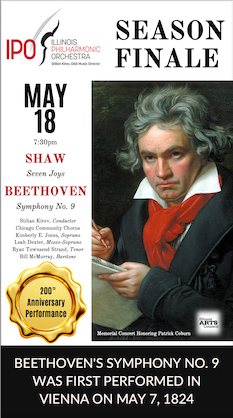Kraemer provides season highlight with a Baroque carnival of the animals

Music of the Baroque’s penultimate program of the year, titled “Birds, Frogs, Crickets & Dogs,” at first glance seemed to risk the routine.
Comprised of shorter works by Vivaldi, Telemann, and Haydn with animal connections, Sunday’s performance at Skokie’s North Shore Center for the Performing Arts in fact proved anything but, with principal guest conductor Nicholas Kraemer, eliciting stellar performances of engaging and in some cases highly unexpected repertoire in one of the highlights of MOB’s season.
The program’s genuine revelations were two obscure works by Georg Philipp Telemann, the first of which was his Grillen-Symphonie (“Crickets” Symphony). As Jennifer More explained in her expert program note, the German word Grille can mean either “cricket” or “whim,” and Telemann seems to play with both connotations in this unconventional score.
Grillen-Symphonie is scored for two concertante double basses and with prominent roles for a trio of flute (doubling piccolo), oboe, and clarinet (the modern equivalent of the alto chalumeau Telemann wrote for), plus strings and continuo. In the first movement, the two bass soloists—Collins Trier and Sam Shuhan—frantically saw their instruments in an evocative and amusing imitation of cricket legs, doing so in conversation with the well-blended wind trio of Mary Stolper, Anne Bach, and Zachary Good.
The ensuing Tändelnd (“Trifling”) oscillates between the tender and the austere, never really settling, and the final Presto feels like a Baroque precursor to the famous “Farandole” from Bizet’s L’Arlesienne, with piping piccolo and a military propulsion that accelerates to the coda. Kraemer led a performance that did justice to the work’s striking ingenuity and highlighted its many idiosyncrasies to great effect.
The discoveries did not end there. To open the second half, concertmaster Gina DiBello was the soloist in Telemann’s Violin Concerto in A Major, “Die Relinge” (“The Frogs”). The concerto begins with an innocent tutti ritornello, before the orchestra drops out and the soloist is left alone making the static effect of playing the same pitch but crossing on different strings. This gesture recurs in both the solo line and the ensemble, and near the close of the first movement is interrupted by a cacophonous din from the whole orchestra. Kraemer’s interpretation was that Telemann was capturing how a frog sits still before leaping into motion, and he charted the movement’s jarring pivots in a manner that made a compelling case for this reading.
The violas have the same static string crossing in the central Adagio, over which DiBello engaged in a limpid dialogue with her supporting colleagues in a meditative aria. “Die Relinge” closes, oddly, with a Menuet, with DiBello dispatching swirling filigree on the repeat to conclude the intriguing, even baffling work.
DiBello was also featured in Vivaldi’s “Spring” Concerto from The Four Seasons to open the afternoon. Animal effects abound in Vivaldi’s well-worn concertante work, and DiBello chirped convincingly with counterparts Kevin Case and Sharon Polifrone in the Allegro. She inhabited the hushed nocturnal air of the central Largo, with violist Elizabeth Hagen imitating the somnolent barks of a shepherd’s dog, and the final Allegro pastorale had the apt open-air, bacchic lilt from soloist, conductor, and ensemble alike.
Longtime MOB principal flute Mary Stolper was showcased in another Vivaldi concerto, “Il gardellino” (“The Goldfinch”) to close the first half. Stolper was an assured soloist, conveying the avian elements of her solo line in the opening Allegro and singing an eloquent sarabande in the Larghetto cantabile, which Kraemer sensibly accompanied with only the principal strings. Stolper’s shimmering tone served the final boisterous Allegro well, with Kraemer showing her the same sensitive support he provided DiBello.
The afternoon closed with Haydn’s Symphony No. 83 in G Minor, “The Hen.” Haydn did not provide this work its nickname, which in fact comes from an unassuming dotted gesture that originates in the oboe in the first movement. As Kraemer remarked, “The Hen” is a throwback to the sturm und drang of his symphonies numbered in the 40’s, and from the angular, tritone-outlining opening gestures he led a performance that wholly captured the score’s drama and motion.
Conducting from memory, with the strings to his left and winds to his right, Kramer brought vigor to the Allegro spiritoso, with Anne Bach clucking appropriately in the brief passage that lent the work its name. Kraemer achieved impressively soft dynamics in the Andante, setting up jagged interjections before a warmly sonorous close.
The Menuet went with courtly, sure-stepping grace, with a gracious strain for flute and violins in the trio. The headlong final Vivace had the feel of a hunting rondo, with nimble work from the principal winds, and was received with roaring applause from the Skokie audience.
WFMT personality Oliver Camacho was on hand as “presenter” for the performance, and conducted brief on-stage interviews with Kraemer during the stage changes. Camacho is an affable presence but these stage discussions felt awkward in their rushed, unrehearsed interactions. Kraemer has shown over the years that he is perfectly capable of offering solo color commentary without assistance.
The program will be repeated 7:30 p.m. Monday at the Harris Theater. www.baroque.org
Posted in Performances



